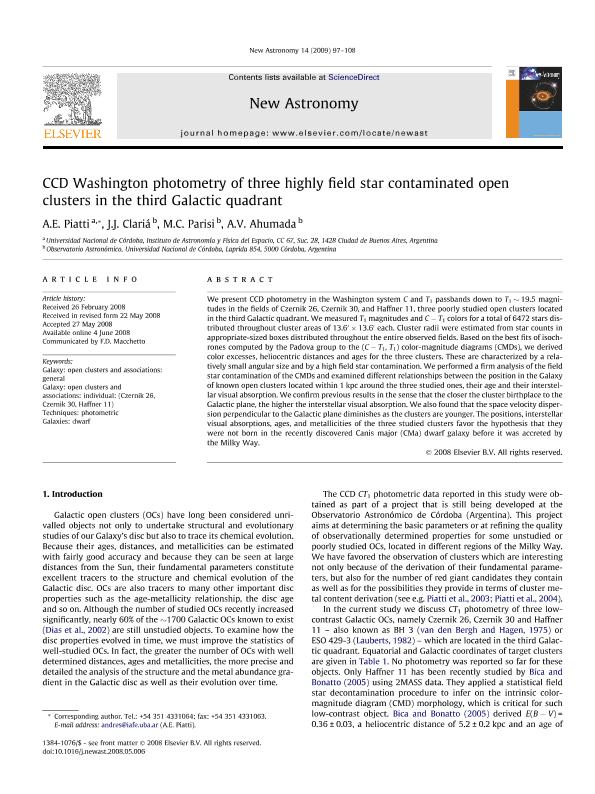Mostrar el registro sencillo del ítem
dc.contributor.author
Piatti, Andres Eduardo

dc.contributor.author
Claria Olmedo, Juan Jose

dc.contributor.author
Parisi, Maria Celeste

dc.contributor.author
Ahumada, Andrea Veronica

dc.date.available
2017-08-04T19:50:08Z
dc.date.issued
2009-01
dc.identifier.citation
Piatti, Andres Eduardo; Claria Olmedo, Juan Jose; Parisi, Maria Celeste; Ahumada, Andrea Veronica; CCD Washington photometry of three highly field star contaminated open clusters in the third Galactic quadrant; Elsevier Science; New Astronomy; 14; 1; 1-2009; 97-108
dc.identifier.issn
1384-1076
dc.identifier.uri
http://hdl.handle.net/11336/21899
dc.description.abstract
We present CCD photometry in the Washington system C and T1 passbands down to T1 ~ 19.5 mag in the fields of Czernik 26, Czernik 30, and Haffner 11, three poorly studied open clusters located in the third Galactic quadrant. We measured T1 magnitudes and C-T1 colors for a total of 6472 stars distributed throughout cluster areas of 13.6´ x 13.6´ each. Cluster radii were estimated from star counts in appropriate-sized boxes distributed throughout the entire observed fields. Based on the best fits of isochrones computed by the Padova group to the (C-T_1,T_1) color-magnitude diagrams (CMDs), we derived color excesses, heliocentric distances and ages for the three clusters. These are characterized by a relatively small angular size and by a high field star contamination. We performed a firm analysis of the field star contamination of the CMDs and examined different relationships between the position in the <br />Galaxy of known open clusters located within 1 kpc around the three studied ones, their age and their interstellar visual absorption. We confirm previous results in the sense that the closer the cluster birthplace to the Galactic plane, the higher the interstellar visual absorption. We also found that the space velocity dispersion perpendicular to the Galactic plane diminishes as the clusters are younger. The positions, interstellar visual absorptions,<br />ages, and metallicities of the three studied clusters favor the hypothesis that they were not born in the recently discovered Canis Major (CMa) dwarf galaxy before it was accreted by the Milky Way.
dc.format
application/pdf
dc.language.iso
eng
dc.publisher
Elsevier Science

dc.rights
info:eu-repo/semantics/openAccess
dc.rights.uri
https://creativecommons.org/licenses/by-nc-sa/2.5/ar/
dc.subject
Galaxy: Open Clusters And Associations: General
dc.subject
Galaxy: Open Clusters And Associations: Individual (Czernik 26, Czernik 30, Haffner 11)
dc.subject
Techniques: Photometric
dc.subject
Galaxies: Dwarf
dc.subject.classification
Astronomía

dc.subject.classification
Ciencias Físicas

dc.subject.classification
CIENCIAS NATURALES Y EXACTAS

dc.title
CCD Washington photometry of three highly field star contaminated open clusters in the third Galactic quadrant
dc.type
info:eu-repo/semantics/article
dc.type
info:ar-repo/semantics/artículo
dc.type
info:eu-repo/semantics/publishedVersion
dc.date.updated
2017-07-28T15:06:33Z
dc.journal.volume
14
dc.journal.number
1
dc.journal.pagination
97-108
dc.journal.pais
Países Bajos

dc.journal.ciudad
Amsterdam
dc.description.fil
Fil: Piatti, Andres Eduardo. Consejo Nacional de Investigaciónes Científicas y Técnicas. Oficina de Coordinación Administrativa Ciudad Universitaria. Instituto de Astronomía y Física del Espacio. - Universidad de Buenos Aires. Facultad de Ciencias Exactas y Naturales. Instituto de Astronomía y Física del Espacio; Argentina
dc.description.fil
Fil: Claria Olmedo, Juan Jose. Universidad Nacional de Cordoba. Observatorio Astronomico de Cordoba; Argentina. Consejo Nacional de Investigaciones Científicas y Técnicas; Argentina
dc.description.fil
Fil: Parisi, Maria Celeste. Universidad Nacional de Cordoba. Observatorio Astronomico de Cordoba; Argentina. Consejo Nacional de Investigaciones Científicas y Técnicas; Argentina
dc.description.fil
Fil: Ahumada, Andrea Veronica. Universidad Nacional de Cordoba. Observatorio Astronomico de Cordoba; Argentina. Consejo Nacional de Investigaciones Científicas y Técnicas; Argentina
dc.journal.title
New Astronomy

dc.relation.alternativeid
info:eu-repo/semantics/altIdentifier/doi/http://dx.doi.org/10.1016/j.newast.2008.05.006
dc.relation.alternativeid
info:eu-repo/semantics/altIdentifier/url/http://www.sciencedirect.com/science/article/pii/S1384107608000717
Archivos asociados
